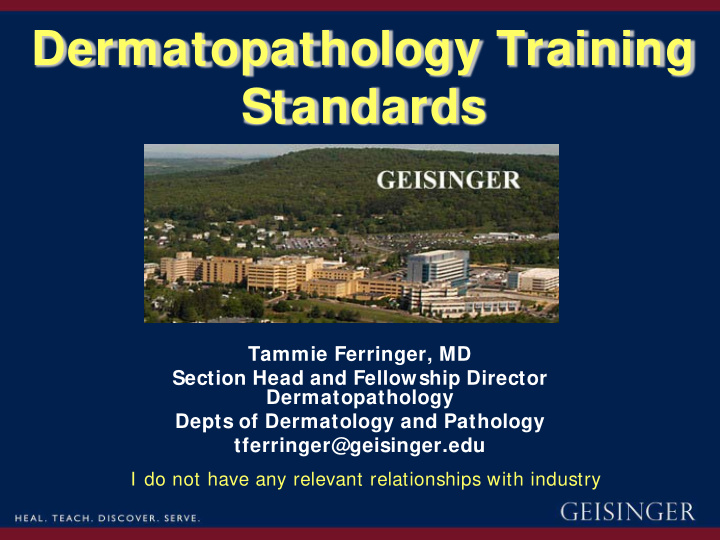



Dermatopathology Training Standards Tammie Ferringer, MD Section Head and Fellowship Director Dermatopathology Depts of Dermatology and Pathology tferringer@geisinger.edu I do not have any relevant relationships with industry
Training 1. What are our goals? 2. How do we achieve these goals? 3. How do we evaluate attainment of theses goals?
Dermpath Training (1) What are our goals? • Pass the boards • Read own dermpath slides and know limitations • “Clinical dermatology is learned best through dermatopathology”
Goals in DP • Accurately identify common and uncommon entities • 13% of PD report no specific DP • Correlate with objectives clinical findings • Know ancillary tests • Understand process and limitations • Know when to refer
Beginning Junior Senior Graduating Advanced Resident Resident Resident Resident •Identify basic •Recognizes •Correctly histology of skin patterns of identifies findings •Correctly identifies Derms interpreting own and inflammatory inflammatory and of common skin cells common disorders; often histopathologic biopsies: neoplastic correctly conditions identifies less common •Often correctly findings of uncommon disorders •Maintain ability to correctly identifies common skin disorders •Has expanded skin disorders DDX •Has a limited diagnose most skin tumors DDX of pathologic •Recognizes findings histologic •Has exhaustive DDX and inflammatory disorders features of most •Knowledge of DIF skin tumors and IIF and correct location for •Knowledge of •Correctly identifies •Fulfill CLIA requirements biopsies indications and cost of IF and •Knowledge of histologic features of IHC relevant special •Knows when to obtain stains skin tumors and special stains and/or send disorders for consultation Derms sending out biopsies: •Understands limitations of Medical laboratory processes and Knowledge qualifications of physician signing out cases
Beginning Junior Senior Graduating Advanced Resident Resident Resident Resident •Understands need • Sometimes •Usually able to for cpc interprets and interpret and apply •Completes applies findings to clinical pathology findings to care, including •Accurately •May have requisition forms clinical care, uncommon particularly neoplasms and interprets and obtained common common neoplasms inflammatory dermatoses • Understands correlates all advanced value of •Usually interprets special stains the results of specimens to training in special stains • Reviews own biopsy slides patient care dermpath and as appropriate teaches cpc •Recognizes limitations and challenges of dermpath interpretation Patient Care
Dermpath Training (2) How do we achieve these goals? • ACGME guidance • Program specific curriculum
ACGME Dermatology Program Requirements • “Residents will examine routinely stained histologic sections from the full spectrum of dermatologic disease. A significant portion of this exposure must occur in an active faculty-run sign-out setting, but the use of conferences and study sets are necessary to complete resident education and are critical in the curriculum. Training must include education relating to interpretation of direct immunofluorescence specimens, appropriate use and interpretation of immunohistochemistry (special stains, including immunoperoxidase) and electron microscopy.”
DP Education Survey • Objective: – Current curriculum – Barriers – Opportunities for improvement • All derm programs listed on ACGME – 55 residents replied – 14 PD replied
Results-Curriculum • 77% of programs require a DP rotation of at least 3 months total during training • Only 20% reported a DP rotation in the first year
Geisinger DP Rotation • Daily sign-out (half day continuity clinic) • 4 weeks in all three years of training
Results-Curriculum • 93% of programs have at least weekly DP conferences – Two-thirds with: • Reading assignments • Pre-view of unknown slides • Glass slide review at multi-head scope
Geisinger DP Conference • 2 hours weekly • Reading assignment • 20 unknowns • Rapid fire in chapter • Rapid fire outside the box
Results-Curriculum • Exposure to specimen grossing, tissue processing, DP billing, and lab management are not part of the great majority of programs • 40% of residents never see their own biopsies histologically
Results-Barriers • Limited resident time for DP rotations due to other service commitments • Inadequate DP faculty or time for teaching • Inadequate glass slide study sets
Dermpath Training (3) How do we evaluate attainment of these goals? • Certifying exam • In service exam • Program exam • Faculty evaluation
ABD Certifying Exam • “Examination in Dermatopathology: Candidates are questioned on 36 glass histopathologic slides that they examine on microscopes provided by the Board. This section of the examination encompasses the entire spectrum of dermatopathology.” • 1.5 hours (20% of 8 hour exam)
ABD In Service Exam • No glass slides • Approximately 25 of 220 questions (10%)
Program Exams • Other than ITEs, nearly half of programs do not formally examine the residents’ DP skills
What about evaluation of our other goals? • Faculty evaluation – Recognize diagnosis of classic cases – Use DP knowledge to plan biopsies and communicate key information • Judge thickness of anatomic site • Select location, size and depth based on DDx – Integrate DP with clinical scenario for best Dx and Tx plan – Able to sign-out their own slides and know their limits
Food for Thought • Goals • Curriculum • Outcome Measurement
Food for Thought • More dedicated DP faculty • More protected time on sign-out • Include DP early in residency – Basis for understanding pathophysiology – Improves biopsy technique – Provides exposure prior to fellowship applications
Food for Thought • Provide exposure to specimen grossing, processing, and lab management – Troubleshoot their own lab – Understand the limitations • Periodically examine DP knowledge – Decrease “test anxiety” – Identify deficiencies early
Food for Thought • Optimize glass slide based conferences and study collections Alternatives? – Online image libraries – Virtual microscopy Advantages Disadvantages Doesn’t require scopes Costs Doesn’t deteriorate Technology Access to uncommon Not in clinical use or on diagnoses exams
Food for Thought • Integration with clinical derm – Enhance CPC with review of own biopsies – Structure of DP rotation: single days vs block – Correlate clinical conference topics with DP conference topics – Clinical photos available at sign-out
Sources of DP Education • http://www.dermpathmd.com/prog.htm • http://www.mydermpath.com/ • http://www.virtualdermpath.com/index.aspx • http://www.derm-oid.com/ • http://derm101.com/start.aspx • http://www.healthcare.uiowa.edu/dermatology /DPT/Path-Index.htm • http://slidetutor.upmc.edu/
Recommend
More recommend